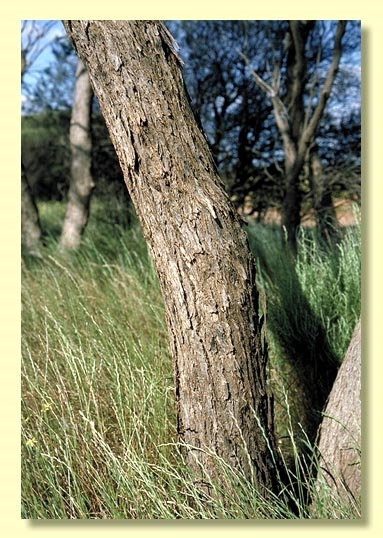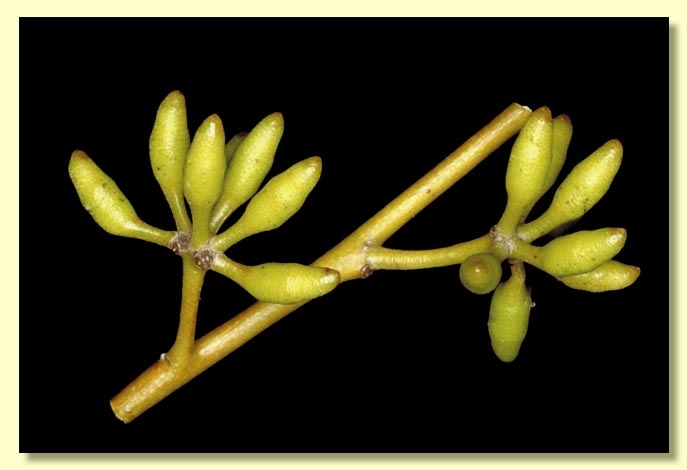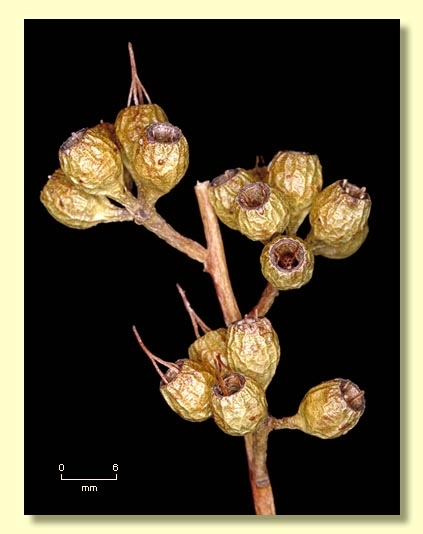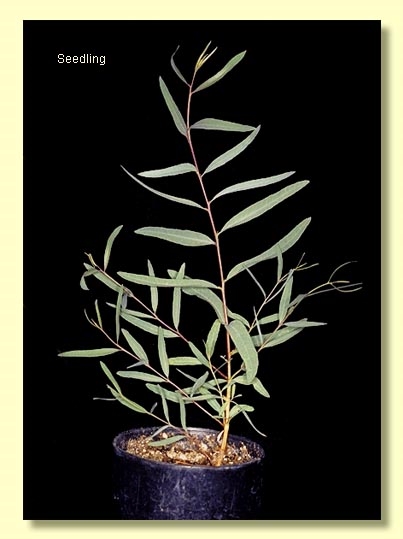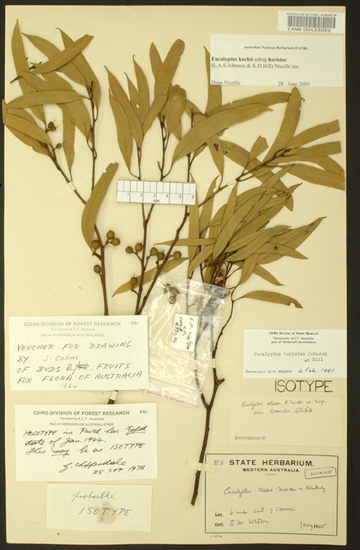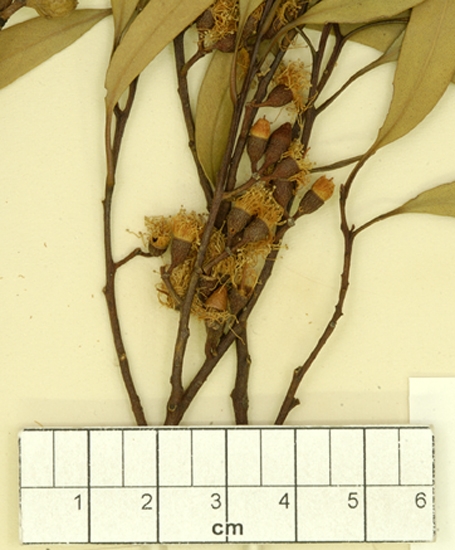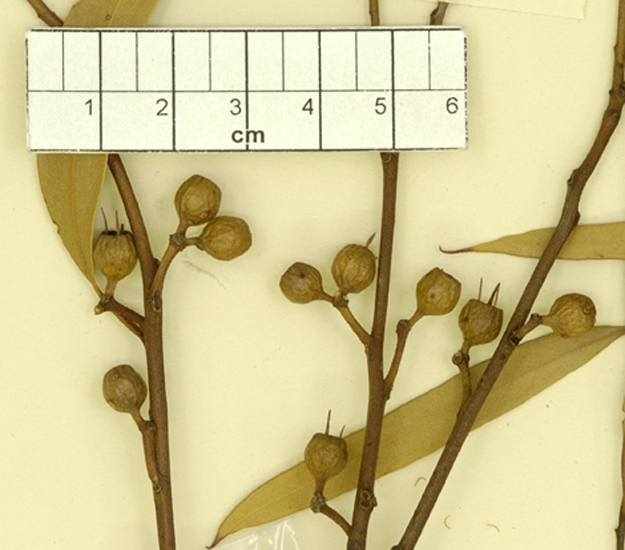Eucalyptus | Symphyomyrtus | Bisectae | Destitutae | Subulatae | Oleaginae
Euclid - Online edition
Eucalyptus kochii subsp. borealis
[This taxon was previously referred to as Eucalyptus horistes. The type specimen for the name E. horistes is now regarded as being part of Eucalyptus series Porantherae.]
Bark usually rough over most of the stems and sometimes extending to the larger branches, flaky fibrous, sometimes fissured, usually firmly held, light grey, smooth bark above grey over red-brown.
Branchlets lacking oil glands in the pith.
Juvenile growth (coppice or field seedlings to 50 cm): not seen.
Adult leaves alternate, petiole 0.7–1.5 cm long; blade narrowly lanceolate to lanceolate, 5.5–11 cm long, 0.6–1.4 cm wide, base tapering to petiole, concolorous, usually slightly glossy to glossy, rarely dull, green, side-veins at an acute or wider angle to midrib, densely to very densely reticulate, intramarginal vein parallel to and just within margin, oil glands numerous and mostly intersectional.
Inflorescence axillary unbranched, peduncles 0.5–1.2 cm long; buds 9 to ?15 per umbel, pedicellate, pedicels c. 0.3 cm long. Mature buds broadly fusiform to ovoid (c. 1 cm long, c. 0.4 cm wide), scar present, operculum conical to horn-shaped (c. 0.5 cm long), sometimes slightly beaked, stamens irregularly flexed, anthers adnate to weakly versatile, basifixed, globoid, dehiscing by lateral pores, style long, stigma tapered, locules 3 or 4, the placentae each with 4 vertical ovule rows. Flowers white.
Fruit pedicellate, pedicels 0.2–0.4 cm long, urceolate to truncate-globose to barrel-shaped, 0.5–0.9 cm long, 0.4–0.7 cm wide, disc descending, valves 3 or 4, valve tips strongly exserted due to fragile style remnants.
Seeds light brown to grey, 1–1.5 mm long, ovoid or flattened-ovoid, occasionally with shallow longitudinal furrows on otherwise smooth dorsal surface, hilum ventral.
Cultivated seedlings (measured at node 10): cotyledons Y-shaped (bisected); stems rounded to square in cross-section; sometimes slightly warty, leaves opposite, sessile to very shortly petiolate and linear to narrowly elliptical for the first 2 or 3 nodes then alternate, subsessile to shortly petiolate and becoming narrowly elliptical to narrowly lanceolate further up the stem, 3.3–9 cm long, 0.5–1.5 cm wide, dull grey-green to green.
Flowering has been recorded in February.
Eucalyptus kochiiis a mallee species widespread in south-western Western Australia from near Narembeen, north to almost Kalbarri, then extending eastwards into the Sandstone–Menzies–Yellowdine area. The bark is rough to the small branches and firm on most of the stems. The juvenile leaves are relatively narrow, the peduncles and pedicels are relatively short and the fruit normally slightly urceolate to barrel-shaped.
Eucalyptus kochii belongs in Eucalyptus subgenus Symphyomyrtus section Bisectae subsection Destitutae because buds have two opercula, cotyledons are Y-shaped and branchlets lack oil glands in the pith. Within this subsection E. kochii is part of a large taxonomic series Subulatae further characterised by globoid basifixed anthers, grey smooth seeds with shallow longitudinal furrows, and fruit with persistent exserted style remnants. Series Subulatae is divided principally into four subseries based on the juvenile leaves, one with spiral, crowded seedling phyllotaxis (subseries Spirales), another with decussate and decurrent seedling leaves (subseries Decurrentes), another with decussate non-decurrent seedling leaves (subseries Decussatae), and a fourth to which E. kochii belongs with disjunct, petiolate seedling leaves (subseries Oleaginae).
Within the group, E. kochii is probably closest to E. longissima. E. longissima can be distinguished by its often large stature, the small globose fruit and the long slender peduncles and pedicels. E. ultima and E. eremicola, the other members of the subseries Oleaginae, are either smooth-barked or have a small amount of rough bark at the base of the trunks; E. kochii is fully rough-barked.
There are five subspecies:
E. kochii subsp. kochii
Occurring in the northern wheatbelt only, restricted to the area north of Dowerin towards Perenjori and west towards Watheroo. It is distinguished from subsp. plenissima and subsp. amaryssia by the conical opercula (rounded in subsp. plenissima and subsp. amaryssia) and the very high oil content of the leaves. It is distinguished from subsp. borealis and subsp. yellowdinensis by the duller adult leaves (usually very glossy in subsp. borealis and subsp. yellowdinensis).
E. kochii subsp. amaryssia
Of scattered occurrence in the northern goldfields south from Meekatharra to the Die Hardy Range – Mt Jackson area, as far east as the Menzies area and west to the Pindar area. Very closely related to subsp. plenissima, with both possessing rounded opercula. It differs by having very glossy adult leaves.
E. kochii subsp. borealis
Occurring from Kalbarri National Park to just south of Morawa. Distinguished within the group by its slightly broader, very glossy adult leaves and by its conical opercula.
E. kochii subsp. plenissima
A mallee occurring in the central wheatbelt, extending into the drier country further east. It is easily distinguished from subsp. kochii, subsp. borealis and subsp. yellowdinensis by the hemispherical opercula. It is very close to subsp. amaryssia, with both possessing round opercula. Subsp. amaryssia differs by having very glossy adult leaves. On distillation and analysis the leaves are found to be very low in essential oils.
E. kochii subsp. yellowdinensis
Of scattered occurrence in the Bodallin to Boorabin area and possibly further south into the Bremer Range area. Like subsp. borealis, the adult leaves are glossy and the buds have sharply conical opercula. Subspecies yellowdinensis is distinguished by having narrower adult leaves, usually narrower than 0.9 cm.
subsp. borealis: Latin borealis - north or northern, referring to the northern distribution of this subspecies within the E. kochii complex.


